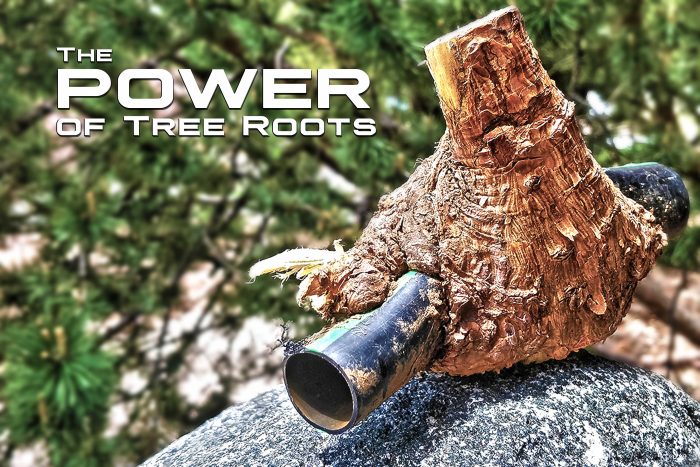The Power of Tree Roots

The Power of Tree Roots
The tallest tree in the world is a California Redwood, which stands 379 feet tall. That’s slightly taller than the length of a football field. To support these giant organisms, trees have an immaculate root system. Surprisingly, however, the roots of most trees remain in the top 18 inches of soil. However some root systems grow up to twenty feet into the soil. To grow into the massive organisms they are, trees must also consume plenty of water. According to Mother Nature Network, one mature oak can consume over 40,000 gallons of water annually.
Trees need water to:
- Cool the leaves
- Provide nutrients
- Exchange oxygen and carbon dioxide
In circumstances when water is scarce, roots will search for water nearby. Surprisingly, this is a threat to the water lines for your home.
How could the power of root systems affect your life? A property full of trees could create issues for your plumbing and other underground pipes on your property. Roots can sense water nearby by following moisture vapors which escape from cracks or holes in water lines. Tree roots are powerful enough to puncture the pipes to reach the water inside. Thin, string-like roots can continue to enter the existing holes, forming bundles of roots inside the pipe. Debris flowing from the home gets caught in the mound of roots in the pipes. As the pipes clog, you’ll notice slower water drainage. If the problem persists into a complete blockage, sewage water could back up into your home. It’s also possible that the pipe could collapse after too much pressure is built up.
The severity of the risk of root intrusion varies depending on the type of pipes.
- Steel: vulnerable to corrosion. Common on homes that are 25 years or older. These aged pipes have become porous over the years, at the end of their life cycle.
- Terracotta (Clay): Like steel pipes, clay pipes are common on homes that are 25+ years old. Over the years, the surface of the pipe has worn out and become permeable. Both steel and clay pipes are highly vulnerable to damage from tree roots.
- Concrete: vulnerable to root intrusion.
- PVC: Because PVC has fewer, tightly fitted joints, these pipes are less susceptible to root intrusion. Joints are where two pipes connect. Fewer joints means fewer points of entry for the roots to target.
What are some warning signs that there are tree roots growing in your pipes?
- If there are tree roots destroying your pipes, you may just smell rotten eggs around your house from the sewage.
- Sinks, toilets, and showers start to drain very slowly. Or, if you flush your toilet and hear a bubbling sound, something may not be right.
- A backed up toilet is a sign you may need to call a professional.
- If a sinkhole forms in your yard, do not go near it. Call a professional ASAP.
In the future, find out where the utility lines are before planting any trees to avoid the risk of severe water damage to your home.
Do you have questions about your insurance? Find an insurance agent near you with our Agent Finder
Search All Blogs
Search All Blogs
Read More Blogs
Smart Car Buying: Beyond the Sticker Price
Unlock the hidden costs of car ownership.
6 Simple Steps to Supercharge Your Home Security
Simple, affordable ways to protect your home.
Beyond Boredom: Unearthing the Surprising Stories Behind Our Favorite Board Games
Game night secrets revealed! Discover the surprising origins and quirky facts behind your beloved board games.
Avoiding the Pitfalls: Common Mistakes of At-Home Businesses
Launch your home business right! Learn to avoid the common errors that can derail your entrepreneurial dreams.
Your Life Insurance Recipe: Crafting the Perfect Blend for Your Family’s Future
Find your perfect life insurance mix: Learn how to blend term and permanent policies for optimal family protection.
From Ford’s Innovation to Today’s Marvel: Unveiling the Secrets of Modern Car Production
Beyond the assembly line: Discover the surprising speed, customization, and quality checks involved in modern car manufacturing.
Beyond Pizza and Promises: Recognizing When It’s Time to Hire Professional Movers
Time to call the pros? Learn when pizza and beer just won’t cut it for your next move.
Mapping Our Roots: Uncovering the Stories Behind American City Names
City names revealed! Discover the historical, religious, and geographical influences behind the monikers of American cities.
The Agile Approach: Why Short, Focused Plans Are Overtaking the Mammoth Business Blueprint
Ditch the doorstop plan! Discover why concise, adaptable strategies are the new gold standard for business success.
Embracing Tomorrow: The Practical Power of Planning for Life’s Only Certainty
Face the future with confidence: Understand how planning for life’s only certainty with life insurance can provide lasting security.










